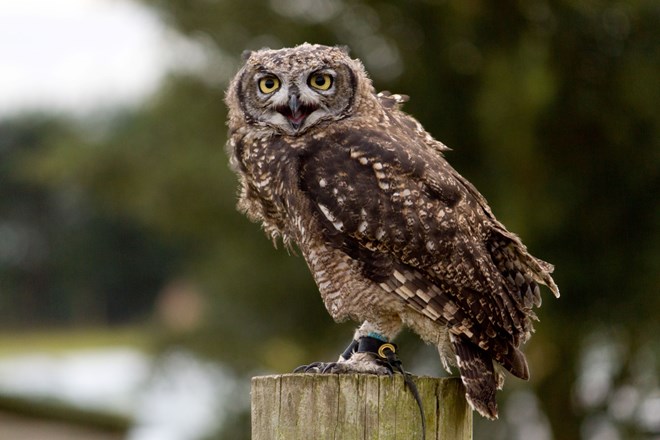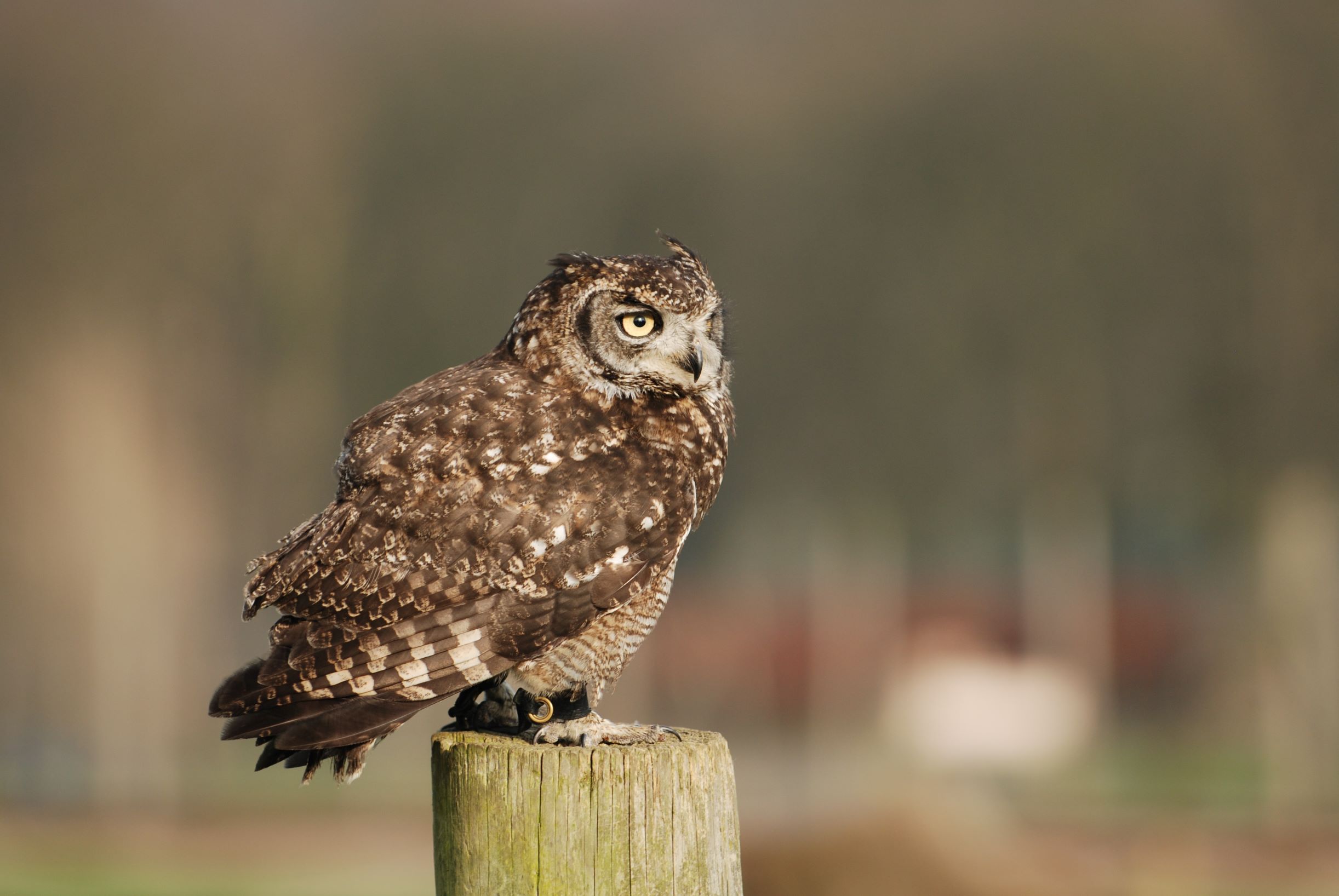
Overview
Here at Woburn we have a male African spotted eagle owl, called Edgar. He always has a lot to say for himself, usually found making his hooting call. He likes to demonstrate how owls spend 85% of their day sat still!

All about us
| Distribution: | Throughout almost all of sub-Saharan Africa, as well as parts of the Arabian Peninsula |
|---|---|
| Habitat: | Rocky desert outcrops, woodland and savannah |
| Height: | 45cm in length |
| Weight: | 480g to 850g |
| Lifespan: | Wild up to 10 years, in captivity up to 20 years |
| Threats: | Traffic accidents and becoming trapped in barb-wired fences |
About us
Scientific name: Bubo africanus
The African spotted eagle owl is the most common species of eagle owl in southern Africa. They have an extremely large range, being found in most of sub-Saharan Africa, and parts of the Arabian Peninsula as well. They have a distinctive appearance with prominent ‘ear tufts’ on the tops of their heads which all members of the eagle owl family have.

The eagle owl family contains some of the largest owls in the world, however the African spotted eagle owl is one of the smallest of the family at only 45cm in length, and up to 850g.
There are regional variations in colour but generally they are a brownish-grey colouration, with large white spots and blotches on the body. The under body and chest are whitish in colour, with fine grey barring. The eyes are bright yellow.
As with all members of the eagle owl family the head features two prominent tufts of feathers, known as the ‘ear tufts’. These tufts have nothing to do with hearing, and their purpose is still not known, however several theories for them exist. A common idea is that they exist to break up the animal’s outline, especially when roosting in a tree, mimicking a broken branch. Others suggest they are to help other owls distinguish each other from other species, or that they are to make them look more threatening to other owls and predators. They can be used to gauge the mood of an owl, as when they are threatened aggressive they will flatten them to their head, and when they are calm and alert they will put them upright.
The African spotted owl uses its feet to catch its prey. Each toe is strong, and features a long sharp talon. The legs and feet are feathered.
The wings of an owl are finely serrated so that they can fly silently. This is to allow the owl to approach its prey silently without it hearing it first, and so that they owl itself can hear its prey over its own sounds.
The eyes of owls are adapted to be like a pair of binoculars. They are fixed in place, allowing for detailed long distance vision for hunting, but this does mean their close range vision is very poor. To look around the owl has to move its entire head, it is a common myth that they can turn their head all the way around, it actually only rotates around 270 degrees horizontally, and around 90 degrees vertically. To be able to do this the owl has extra bones in their neck. Most vertebrates, including us, only have 7 vertebrae in their neck, whereas an owl has 14.
To cope with the lack of short range vision they have a group of sensitive feathers, called crines, around their beak. These sensitive feathers are used to locate dead prey.
Owls have very sensitive hearing, used to locate prey either hidden under snow or other coverings, or to hunt in the dark. Owl’s ears are holes hidden beneath the feathers, one further up than the other, allowing the owl to pinpoint the location of a sound. This ability lets them build a sort of sound map and locate prey, often in complete darkness, by sound alone. The feathers of an owl’s face help with this hearing, by forming a facial disk, a disk of feathers used like a satellite dish to help point any sound towards these ears.
African spotted owls are nocturnal, meaning they are most active at night. They will usually hunt from an open branch or perch, using a fast powerful flight to swoop down on prey, and are capable of taking bats, birds, and insects in flight. They will often pursue prey on foot as well after swooping down on them. They will often search rock crevices and nest sites for roosting birds and young birds in nests. The strong feet and talons are used to kill the prey, although occasionally the beak can be used to crush the head of smaller prey. Depending on the size of the prey item they will swallow it whole, or if larger tear it apart with the beak. Owls produce a pellet, a small package of all the parts of their food they cannot digest, such as the bones and fur or feathers.
Their diet consists of a wide range of prey; mainly small mammals, birds, bats, insects, amphibians and reptiles. They will also feed on carrion, and are frequently killed in traffic accidents at the roadside because of this. They are often found in urban areas, around street lights hunting large insects.
Pairs can often become territorial over hunting territories, and often kill, or eject from the area, their adolescent offspring to defend the hunting ground.
The wings of an owl are finely serrated so that they can fly silently. This is to allow the owl to approach its prey silently without it hearing it first, and so that they owl itself can hear its prey over its own sounds.
The eagle owl uses a range of communication. The distinctive vocal call of this species is the double or triple ‘hoo hoo’ call, with males making the first, and females the latter. They will also use several other calls including a soft ‘kree’ call made by young owls when with a companion. When threatened or active aggressively they will make a loud clicking noise with their beak, and can produce a hissing noise. Calling can be territorial, threatening, or used during courtship.
When performing a threat display they will puff up their feathers, hold their wings up behind them, and try to appear as large as possible.
There is a white patch on the throat, which is exposed when the bird calls, this is thought to enhance communication during darker times, allowing others to recognise calling individuals by the throat patches.
African spotted owls are monogamous, meaning they pair for life, and will often return to the same nest site for several years. Some sites have been observed to have been in use for over forty years by successive pairs.
Breeding occurs usually from July to February. The pair will build a nest together, creating a small scraped out hollow on the ground, often hidden in grass, among rocks, or under a bush.
The female lays two to three eggs, which she will then incubate for around a month. The male will bring her food to the nest during this time. Female owls are generally a third larger than the male, so that they have the extra energy to incubate the eggs and can survive this period.
Once the eggs have hatched the young will stay in the nest being fed by the parents until around 30 to 38 days old, when they will learn to fly. Once they have fledged they will still rely on the parents for a further five months.
The African spotted owl reaches sexual maturity at around one year, and can live up to 10 years in the wild, or up to 20 years in captivity.
The African spotted eagle owl is the most common species of eagle owl found in southern Africa. They have a large range which they are common throughout. They are not thought to be threatened at all.
Due to their small size they are often hunted by the larger Verreaux’s eagle-owl, but have no other predators. They are most often killed by becoming trapped in barb-wired fencing, and traffic accidents while eating road kill.
They are listed as appendix II of CITES, which means the trade and export of this species is heavily regulated and controlled to protect them.
Members of the eagle owl family have small tufts of feathers on the tops of their heads called ‘ear tufts’, these are nothing to do with their hearing but are actually more like mood indicators!
Owls produce a pellet every day, a neat package of all of the parts of their food they cannot fully digest, such as bones and feathers!
Owls have 14 bones in their necks to allow them to turn their heads 270 degrees. Humans only have seven, and even a giraffe only has seven!

